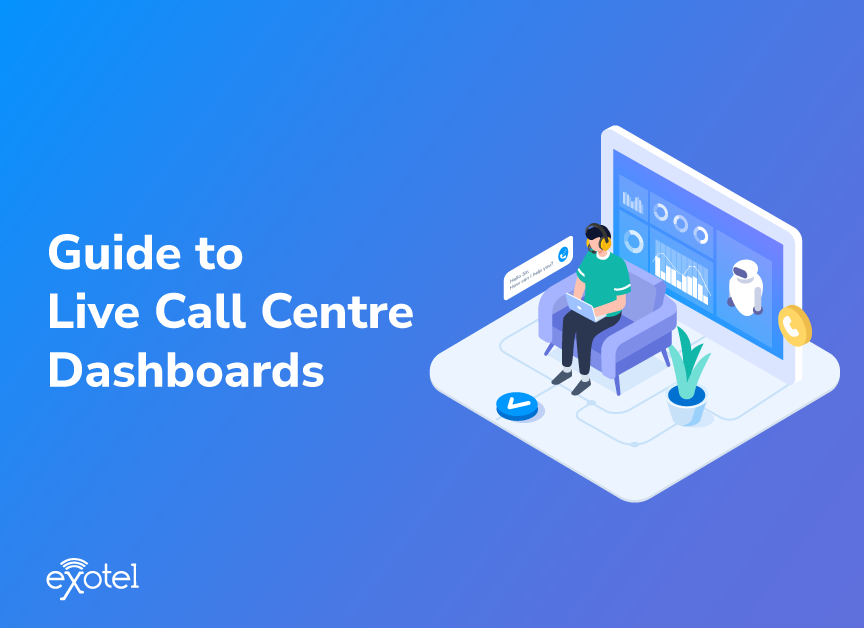In most enterprises, call centers handle a staggering number of inbound and outbound calls every single day. The list grows if you take into consideration missed calls, disconnected ones, calls in queues etc.
A live dashboard is the backbone that holds these call center operations together and gives you visibility into what’s happening, at a glance.
Let’s explore more about the live call center dashboard and what it offers.
What is a live call center dashboard?
A live dashboard is a real-time reporting tool that gives you visibility across key metrics along your contact center workflow. Think of it as a working map to your contact center operations.
For instance, it tells you how many agents are currently on calls, how many are idle etc. It also generates and collates data over time, which helps you figure out bottlenecks and fix them timely such as long queue times.
How does a live call center dashboard work?
Exotel’s live call center dashboard uses advanced analytics techniques to capture, process and visualise data across pre-configured metrics. Currently, it gives you visibility at three levels:
- An overview of all your calls and agents on a daily basis.
- Live agents view of ongoing call traffic as and when it takes place.
- Performance view of individual agents.
Let’s understand these views in detail.

Call center overview
This section gives you a bird’s eye view of the call center — number of calls in progress, agent status, activity so far, comparison with the previous day etc.
You can program the workflow to record and track key performance indicators (KPIs) in your organisation. Commonly used KPIs are call volume, completed calls, missed calls, average talk time, queue time and the average time to answer. It can even show you data about calls that are abandoned by the caller before being connected to the agent.

This automatic capture and record of data frees up employees from the tedium of maintaining and reporting call logs. It also guarantees the accuracy of the data as the dashboard syncs with real-time operations and automatically updates itself.
Live agents section
In this section, you can see what each agent is doing at the moment: whether they are on a call, free, or offline. It also shows you how long an agent has been in the same state and when they last switched on the device.

The live agents module helps monitor employee availability. You don’t need to contact an agent to confirm their availability if you want to route the calls to them.
Agent performance section
This section tracks key performance metrics for each agent.
- How long the agent was online
- How much of that time was idle (not on calls)
- Number of calls assigned to the agent
- How many of them were completed
- How many went unanswered
- Average time spent on a call
- Total time spent on conversations etc.

These metrics are extremely important for operations leaders to monitor, train and improve the performance of their team members. It offers them real-time visibility into an agent’s activity and their progress over a period.
For instance, if you notice that an agent is taking too long to answer a call or their conversations are going on for too long, you can step in to eliminate roadblocks in their way. If you see trends in specific kinds of enquiries, you can improve your training material and best practices.
7 Benefits of using a live call center dashboard
The pandemic has accelerated the adoption of cloud telephony — the industry is predicted to grow at 17.8% in 2021, double the previous year’s growth. (Source: Statistica) Your remote teams and field sales staff can also use your contact center solution, opening doors to opportunities as well as challenges.
How would operations leaders know what their large and distributed teams are doing when they’re not in the same room as them? This is where live call center dashboards help.
- It gives you real-time visibility into operations at all times.
- It centralises all call-related data in one place, so you don’t have to refer to multiple applications.
- It can be used to trigger action based on pre-set conditions, for example, reminding an agent when a call is in the queue too long.
- It reveals patterns of inefficiencies that reduce productivity.
- It generates analytical reports that you can use to make better decisions.
- It can easily accommodate changes to call flow and removal or addition of agents.
- It can help set realistic goals for improving performance, both at the agent level and the organisational level.
Exotel’s live call center dashboard goes the extra mile
Working with some of the most forward-thinking businesses, we’ve learned that a dashboard is most effective when it meets the specific needs of your organisation. This is why we’ve made our live call center dashboard flexible and customisable.
Exotel lets you drag and drop applets to create your workflow in the dashboard — no need for coding or developers! And since our telephony solution is hosted on the cloud, you get to plug and play anywhere, with no loss of data or downtime. Speak to us to switch over to cloud telephony today.
 +91-808 8919 888
+91-808 8919 888 +91-808 8919 888
+91-808 8919 888 +966 135 181 912
+966 135 181 912



